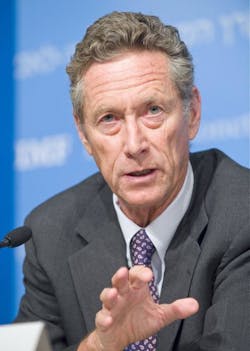That’s today’s predicament as, despite increasingly robust freight volumes, the ongoing truck driver shortage in the U.S. may now be poised to create more difficulties rather than opportunities for motor carriers.
Add to that a surprising downgrade to the global economic growth forecasts by the International Monetary Fund (IMF) and suddenly the view of the road ahead for trucking looks a bit more difficult than before.
First, let’s look at the U.S. freight picture.
According to Bob Costello, chief economist for the American Trucking Associations (ATA), freight volumes are in his view “growing nicely on a year-over-year basis” for most sectors of the trucking business.
Indeed, the latest reading of the group’s for-hire truck tonnage index showed an increase of 1.6% in August, following a gain of 1.5% in July.Year-to-date, compared with the same period in 2013, tonnage is up 3.1%, which is definitely good news for carriers larger and small.
“Industry revenue and average revenue per mile are increasing nicely as capacity remains constrained,” Costello (seen at left) noted during a presentation at the ATA’s annual conference this week in San Diego.
“However, the industry is having a difficult time adding trucks due to the driver shortage; it’s as bad as ever and is expected to get worse in the near term,” he stressed.
As evidence, Costello reported that turnover – often a proxy for tracking the driver shortage – rose 11 percentage points to an annualized rate of 103% in the second quarter this year; the highest it’s been since the third quarter of 2012.
Turnover at small truckload fleets – fleets with less than $30 million revenue – surged 16 points to 94%, also the highest it’s been since the third quarter of 2012, he added.
“These turnover rates shows that the driver shortage is acute,” Costello emphasized. “And if the freight economy continues to grow, it will worsen very quickly.”That being said, the global economic data being analyzed by the IMF doesn’t exactly herald strong freight growth for the near future.
In its latest World Economic Outlook (WEO), Olivier Blanchard (seen at right), economic counsellor and head of the IMF’s research department, said that the forecast for global growth will average 3.3% in 2014―unchanged from 2013―and should rise to 3.8 % in 2015.
Yet this is a weaker growth outlook for 2014 compared to the one IMF issued back April, reflecting setbacks to economic activity in the advanced economies during the first half of this year and what Blanchard called a “less optimistic outlook” for several emerging market economies.
“These worse prospects are in turn affecting confidence, demand, and growth today,” he noted. “Two underlying forces weigh on global recovery. In advanced economies, the legacies of the pre-crisis boom and the subsequent recession, notably high debt burdens and unemployment, still cast a shadow on the recovery, and low potential growth ahead is a concern.”
Several emerging markets are also adjusting to lower potential growth, Blanchard added, with potential growth rates—that is, the pace at which annual output can expand without pushing up inflation—also being revised downward by the IMF.
“Global growth is still mediocre,” Blanchard added, noting that “economic evolution” is becoming more differentiated in major countries and regions, with the pace of recovery reflecting various country-specific conditions.
That being said, the U.S. for the moment remains in a good place. According to the IMF’s data, much of the projected strengthening in global economic activity reflects faster growth in the U.S. following a temporary setback in the first quarter of this year.Blanchard said U.S. employment growth has been strong, with household balance sheets improving amid favorable financial conditions and a recovering housing market.
However, in Europe, recent growth disappointments highlight lingering fragilities.
“A gradual, but weak recovery is projected to take hold, supported by a sharp compression in interest spreads for stressed economies and record-low long-term interest rates in core euro-area economies,” Blanchard noted.
While growth in emerging market and developing economies will continue to account for the lion’s share of global growth, the IMF noted that the 4.4% rate now predicted for 2014 is “a bit weaker” than what the group projected back in April.
“This slowdown is due to lackluster domestic demand and the impact of increasing geopolitical tensions, especially on Russia and neighboring countries,” Blanchard added.
Some other economic highlights from the October WEO:
- For China, growth is expected to decline slightly in 2014-2015 to 7.4%, as the economy transitions to a more sustainable path. Growth is expected to remain strong elsewhere in emerging and developing Asia.
- In Latin America, the growth rate is forecast to decrease by half this year to around 1.3% due to declining exports as well as domestic constraints but should rebound to around 2.2% in 2015.
- In sub-Saharan Africa, stronger growth is expected because of supportive external demand conditions and strong investment demand, although prospects vary across countries.
- In the Middle East and North Africa, the recovery remains fragile even as growth is expected to start picking up modestly on the back of improving domestic security conditions and improving external demand. Similar considerations underpin modest improvements in activity in Russia and other economies of the Commonwealth of Independent States.
The big worry from the IMF’s point of view, though, are what the group dubs “considerable downside risks” now stalking the world’s economies:
- Heightened geopolitical risks could prove more persistent, and they could also worsen. The result could be sharply higher fuel prices, trade disruptions, and further economic distress.
- Easy financial conditions, and the resulting search for yield, could fuel financial excess. Markets may have underpriced risks by not fully internalizing the uncertainties around the global outlook. A larger-than-expected increase in U.S. long-term interest rates, geopolitical events, or major growth disappointments could trigger widespread disruption.
- In advanced economies, “secular stagnation” or a situation of a persistent shortfall of investment relative to saving, even with near-zero interest rates, combined with low potential growth continue to be important medium-term risks—despite continued very low interest rates and increased risk appetite in financial markets.
- Protracted low inflation or outright deflation, particularly in the euro area, could pose a risk to activity and debt sustainability in some countries.
- For emerging markets, potential growth could be even lower than projected, if supply-side constraints prove more protracted.
All of that certainly casts a shadow over the big economic picture, for sure. Yet with freight volumes up and capacity tight, truckers remain in a pretty good place. So let’s hope that “good place” sticks around for a while.




